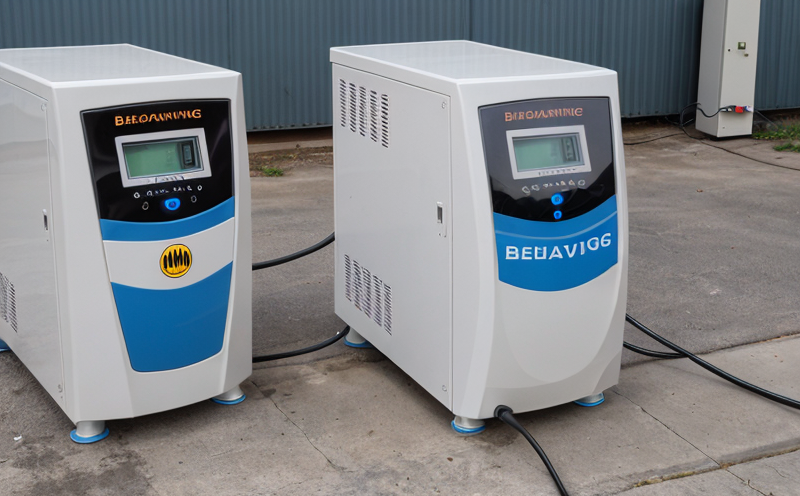IEEE 1725 Charging and Discharging Testing of Rechargeable Batteries for Mobile Phones
The IEEE 1725 standard is a crucial benchmark in the mobile phone industry, ensuring that rechargeable batteries perform reliably under various charging and discharging conditions. This testing procedure is designed to assess the performance characteristics of lithium-ion (Li-ion) and similar chemistries used in portable electronic devices such as smartphones, tablets, and wearables.
The standard provides a comprehensive framework for evaluating the battery's ability to maintain its capacity over time, withstand repeated charge-discharge cycles without degradation, and ensure safe operation within specified limits. This testing is essential for manufacturers aiming to meet regulatory requirements, enhance product durability, and improve user experience through consistent performance across batches.
Compliance with IEEE 1725 not only ensures that the battery meets industry standards but also provides a competitive edge by demonstrating superior quality and reliability. For R&D teams, this test offers valuable insights into potential improvements in battery design and materials selection. Quality managers and procurement officers can rely on these results to ensure they are sourcing high-quality components.
The testing process involves charging the battery under controlled conditions according to specified protocols outlined in IEEE 1725. The discharge phase follows a similar rigorous schedule, ensuring that the battery's performance is assessed accurately throughout its lifecycle. The test conditions include different charge rates, temperature variations, and cycle counts, all of which can impact the battery’s performance.
By using this standardized method, manufacturers can ensure consistent results across production batches, thereby reducing variability in product quality. Additionally, this testing helps identify any potential issues early in the development process, allowing for timely corrections before large-scale manufacturing begins.
The IEEE 1725 standard emphasizes safety as a critical aspect of battery performance evaluation. It specifies stringent criteria for ensuring that batteries can withstand overcharging and deep discharging without risking damage or fire hazards. This focus on safety is particularly important given the prevalence of lithium-ion batteries in consumer electronics, where even minor flaws could have serious consequences.
For R&D engineers working on next-generation battery technologies, compliance with IEEE 1725 provides a benchmark against which they can compare their innovations. By adhering to this standard, they can validate that new designs and materials meet the same high standards as existing products while potentially introducing improvements in efficiency or durability.
The importance of consistent performance cannot be overstated in today’s fast-paced market where customer expectations for reliability are at an all-time high. Companies that invest in rigorous testing like IEEE 1725 not only protect themselves from recalls and lawsuits but also build trust with consumers who value safety and longevity when purchasing electronic devices.
Understanding the nuances of this standard is key to ensuring compliance, especially as regulations evolve around battery safety and performance. By staying up-to-date with industry trends and adhering strictly to IEEE 1725 protocols during production testing, manufacturers can ensure that their products not only meet current standards but also anticipate future requirements.
In conclusion, IEEE 1725 charging and discharging testing is an indispensable tool in the mobile phone industry. It plays a pivotal role in ensuring product reliability, safety, and performance across all aspects of operation. For companies committed to delivering high-quality products that meet stringent international standards, this test offers invaluable support throughout their development processes.
Why It Matters
The IEEE 1725 standard is critical for several reasons:
- Regulatory Compliance: Ensuring compliance with industry and regional regulations regarding battery safety and performance.
- User Safety: Reducing the risk of overheating, short circuits, or fires by evaluating how well batteries handle overcharging and deep discharging.
- Product Reliability: Providing consistent results across production batches to enhance overall product quality.
These factors contribute significantly to building trust between manufacturers and consumers, ultimately driving market success. By adhering to IEEE 1725 standards, companies can differentiate themselves by offering safer, more reliable products that meet or exceed expectations.
Scope and Methodology
The scope of IEEE 1725 covers the evaluation of rechargeable batteries used in mobile phones based on their charging and discharging behavior. This involves a series of tests aimed at assessing various parameters critical to battery performance, including but not limited to:
- Capacity retention after multiple charge-discharge cycles.
- Charge acceptance under different current rates.
- Discharging efficiency over varied loads.
The methodology prescribed by IEEE 1725 outlines specific procedures for preparing the test samples, setting up the testing environment, and conducting each step of the evaluation. These protocols ensure that all tests are conducted consistently across laboratories worldwide, providing reliable data that can be used to compare different batteries effectively.
For instance, during charging cycles, the battery is subjected to controlled current inputs at specified temperatures while monitoring voltage levels closely. Similarly, during discharging stages, precise load conditions are applied ensuring accurate measurement of delivered energy and efficiency metrics.
The standard also emphasizes the importance of real-world simulation in testing, which means simulating actual usage scenarios as closely as possible. This approach helps manufacturers understand how their batteries will perform under typical consumer conditions rather than idealized laboratory settings.
By following these rigorous procedures, laboratories can provide comprehensive reports detailing each battery’s performance characteristics according to IEEE 1725 standards. Such detailed documentation is invaluable for both internal decision-making within the company and external communication with customers or regulatory bodies.





